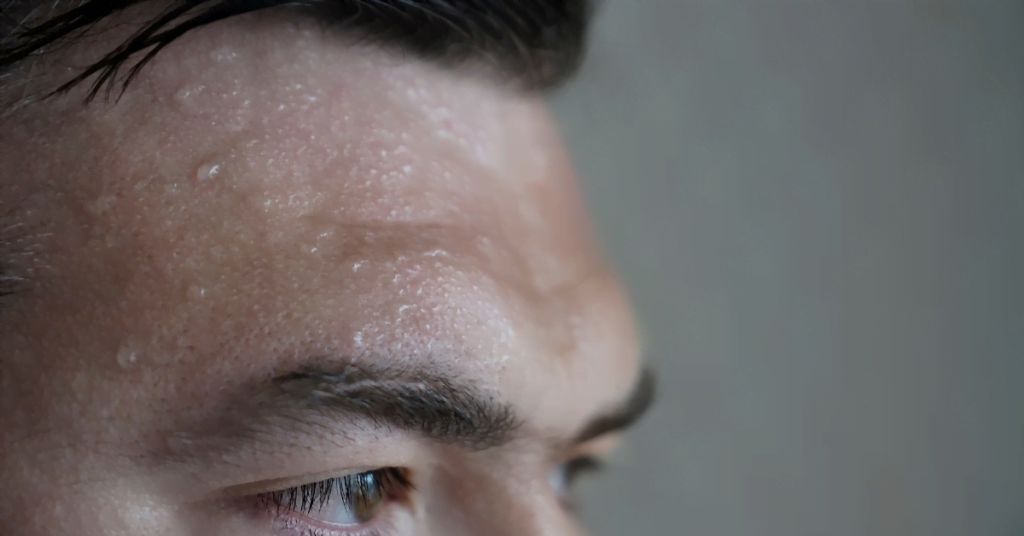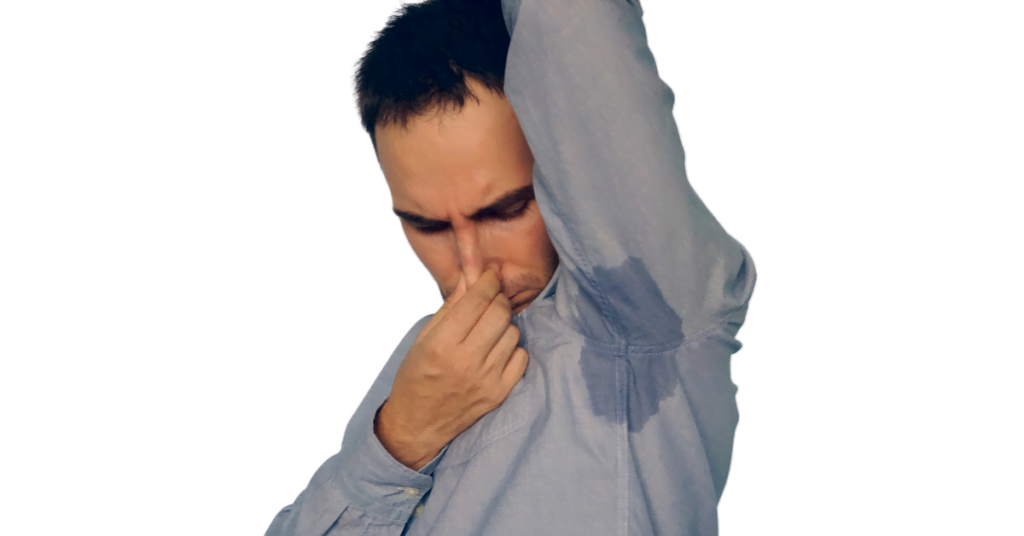
Sweating forms the way our body regulates its temperature. By secreting sweat on our skin and then allowing it to evaporate, natural cooling occurs. This process is vital for keeping our internal body temperature at a stable level, which is crucial for the optimal functioning of numerous body functions.
The role of sweat glands
Sweat glands play a crucial role in our body’s regulatory system. Here we explain exactly what they do:
Temperature regulation: The main job of sweat glands is to help control our body temperature. When our bodies get too hot, such as from exertion, heat or fever, they spring into action. They make sweat, which then evaporates on our skin. This evaporation acts as a natural air conditioner, cooling our bodies.
Secretion of waste products: In addition to water, sweat glands also contain small amounts of waste products such as urea, salts and glucose. By sweating, our body helps get rid of these substances.
Protection: Sometimes sweating makes our skin a little damp, especially in places where the skin rubs against each other, such as under the arms or between the legs. This prevents friction and irritation, like a kind of natural lubrication.
pH Balance: Sweat has a slightly acidic pH, which helps maintain the proper acidity on our skin. This acidity can also help ward off harmful bacteria on the skin.
Emotional reaction: Sweating may increase with certain emotions, such as anxiety, stress or nervousness. This is known as “emotional sweating” and happens mainly in places such as our palms, soles of our feet and armpits.
In our body, there are two main types of sweat glands: eccrine and apocrine glands. The eccrine glands are scattered everywhere and are responsible for most of our sweat. The apocrine glands are mainly located in the armpits and groin area, and they produce a somewhat thicker sweat that, when it comes in contact with bacteria on the skin, can lead to body odor.
Eccrine sweat glands: your body’s cooling masters
Eccrine sweat glands are scattered throughout your body like little cooling masters, except in a few places such as your lips and certain parts of your external genitalia. They play a crucial role in regulating your body temperature and fluid balance. Let’s look at some of the characteristics and tasks of these sweat glands:
Where do you find them? Eccrine sweat glands are found on the entire surface of your body, with the exception of a few areas. They mostly concentrate in places such as your palms, soles of your feet and forehead.
What do they look like? These glands have a tube-like structure and lead directly to the surface of your skin through small channels, where they release sweat directly onto your skin.
What do they do? Their main task is thermoregulation. When your body temperature rises, these sweat glands produce a watery liquid, or sweat. This sweat then evaporates from your skin’s surface, helping to cool your body.
What’s in that sweat? The sweat produced by eccrine glands consists mainly of water, but also contains some salts such as sodium and chloride, as well as small amounts of other substances such as urea and lactate.
How are they activated? Eccrine sweat glands are controlled by the autonomic nervous system, which means you have no conscious control over when they become active. They can be stimulated by internal factors, such as increased body temperature, or by external factors, such as hot weather.
How much sweat do they produce? The daily amount of sweat a person produces through eccrine sweat glands varies depending on factors such as weather, physical activity and individual differences. It can range from about 500 ml to several liters per day.
Thanks to these little cooling masters, we can effectively deal with hot conditions and physical exertion, and ensure that our bodies remain within a safe temperature range.
Apocrine sweat glands: The mysterious odor producers
Apocrine sweat glands are an intriguing contrast to their better-known counterparts, the eccrine sweat glands. Here are some salient features and functions of the apocrine sweat glands:
Where do you find them? Apocrine sweat glands have a specific predilection for the armpits (axillary cavities), the area around the nipples and the groin area. You also find them near the ears, where they produce cerumen (earwax), and around the eyes, where they contribute to the production of tears.
What do they look like? Compared to the eccrine sweat glands, these guys are larger and they drain into hair follicles rather than directly on the skin surface.
What do they do? The exact function of apocrine glands in humans has not yet been fully deciphered, but they come to life during puberty and their secretions may play a role in spreading pheromone-like signals.
What’s in that sweat? The sweat coming from the apocrine glands is thicker and contains fatty acids. At first it is odorless, but as it is broken down by skin bacteria, it can develop those characteristics of smelly sweat and a “body odor.
How are they activated? While eccrine glands are activated by heat and body temperature, apocrine glands often respond to emotional stress, anxiety or hormonal changes.
Development: These glands begin to develop during puberty under the influence of hormones and become larger and more active as you mature.
Because the secretions of apocrine glands can provide a fertile breeding ground for bacteria, it is essential to wash regularly, especially in areas where these glands accumulate, to prevent unpleasant body odors. They may be mysterious, but with proper care, you can keep their fragrant secrets under control.
Symptoms of excessive sweating

Excessive perspiration, also called hyperhidrosis, is a condition in which the body produces more sweat than necessary to regulate temperature without an underlying condition. Here are some symptoms and characteristics of excessive sweating:
Soaked clothing: You regularly have wet spots on your clothes for no apparent reason, especially around your armpits, but it can also occur on other parts of your body.
Wet palms and soles of feet: This can cause discomfort in everyday life, such as when giving a handshake or wearing certain shoes.
Constant sweating: Excessive sweating can be persistent or occur in episodes even when it is not hot or when you are at rest.
Night sweats: You wake up at night with sweat soaked bedding or nightwear for no apparent reason such as fever or nightmares.
Skin problems: Prolonged humidity can lead to skin problems such as skin infections, rashes or irritation.
Unpleasant odor: Although sweat is naturally odorless, the combination of sweat and bacteria on your skin can lead to body odor. Excessive sweating can intensify this odor.
Emotional and psychological effects: People with hyperhidrosis may feel self-conscious, isolated or depressed because of their condition. It can affect social activities, work and general daily life.
Cold or clammy skin: Constant humidity can cause your skin to feel cold or clammy.
White, soft and sore skin: This can occur after prolonged exposure to moisture and is often seen on the soles of the feet of people who suffer from excessive sweating of the feet.
If you suspect you suffer from excessive sweating, it is wise to consult a doctor or dermatologist. They can determine the cause of the problem and recommend appropriate treatment.
Causes of Excessive Perspiration
Excessive perspiration, also known as hyperhidrosis, can have several causes. Here are some of the most common triggers:
- Primary Hyperhidrosis: This is a form of excessive sweating for which there seems to be no obvious reason. It is believed to be related to overactive nerve signals. People with primary hyperhidrosis usually experience unexplained sweating with no underlying cause in specific areas such as palms, soles of the feet, armpits and face.
- Secondary Hyperhidrosis: This type of excessive sweating is caused by an underlying medical condition, certain medications or diseases, such as:
- Medications: Some medications, including antidepressants, antipsychotics and specific painkillers, can cause excessive sweating as a side effect.
- Medical cause: Conditions such as diabetes, hyperthyroidism (an overactive thyroid gland), infections such as tuberculosis, and certain cancers can lead to excessive sweating.
- Menopause: Hormonal fluctuations during menopause can cause hot flashes and night sweats.
- Low Blood Sugar: People with low blood sugar may experience excessive sweating.
- Nerve disorders: Conditions such as Guillain-Barré syndrome or autonomic neuropathy can cause excessive sweating.
- Other factors:
- Caffeine: Excessive caffeine consumption can cause sweating.
- Alcohol: Excessive alcohol consumption can also contribute to excessive sweating.
- Stress and Anxiety: Emotional stress can cause sweat breakouts, especially on the forehead.
- Genetics: If excessive sweating runs in your family, you are more likely to experience it as well.
- Obesity: Overweight or obese people often suffer from excessive sweating because their bodies have to work harder, resulting in more sweat production.
- Infections: Certain infectious diseases can cause fever and excessive sweating.
It is important to remember that everyone is different. What may trigger excessive sweating for one person may not for another. If you are concerned about excessive sweating, it is advisable to contact a doctor. This can help you determine the underlying cause of the problem and recommend appropriate treatment.
Treatments for Hyperhidrosis
Hyperhidrosis, also known as excessive sweating, can be a stressful condition that causes both physical and emotional discomfort. Fortunately, there are several treatment options available to relieve the symptoms of excessive sweating. The following is an overview of some common treatment options for hyperhidrosis:
Antiperspirants:
Some antiperspirants, especially those containing aluminum chloride, may be more effective than ordinary products. They work by temporarily blocking the sweat glands, reducing sweating.
Medication:
- Anticholinergics: These drugs prevent nerve signals from reaching the sweat glands. Examples include oxybutynin and glycopyrrolate.
- Beta blockers: In some cases, beta blockers can help, especially if sweating is caused by anxiety.
- Antidepressants: These can help reduce sweating while treating any concurrent depression or anxiety symptoms.
Iontophoresis:
This is a procedure in which hands and feet are immersed in water, followed by the application of a weak electric current through the water. This can help temporarily block the sweat glands.
Botulinum toxin (Botox) injections:
Botox can block the nerves that activate the sweat glands, which is especially effective for treating excessive sweating in the armpits.
Endoscopic thoracic sympathectomy (ETS):
This is a surgical procedure in which certain nerves that control the sweat glands in the palms are cut. This procedure is usually considered only when other treatments are not effective, due to possible side effects.
Laser therapy:
This method uses laser beams to destroy the sweat glands, especially effective for the armpits.
Microwave therapy:
A device that uses microwave energy can be used to destroy sweat glands, usually applied to the armpit areas.
Newer treatments:
New treatments and medications are constantly being researched to help people with hyperhidrosis. It is wise to consult regularly with a dermatologist to stay abreast of the latest treatment options.
Choosing the right treatment depends on the severity of the hyperhidrosis, the specific area of the body affected, and the patient’s personal preference. A dermatologist or other medical specialist can help determine which treatment is most appropriate for each individual.
